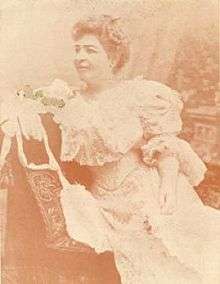Siranush
| Siranush | |
|---|---|
 | |
| Born |
Merobe Kantarjian May 25, 1857 Constantinople, |
| Died |
June 10, 1932 (aged 75) Cairo |
| Resting place | Armenian Cemetery |
| Nationality | Armenian |
| Occupation | Actress |
Merobe Kantarjian (Armenian: Մերոպե Սահակի Գանթարճյան) Siranuysh or Siranush or Siranoush (Armenian: Սիրանույշ) was born on May 25, 1857, in Constantinople and died on June 10, 1932, in Cairo) at the age of 75, and was buried in the Armenian Cemetery alongside the tomb of the famous Armenian satirist, Yervant Odian. Siranush was a famous ethnic Armenian actress,[1] one of the few whose work is tied to an entire era of theatrical history. Her artistic career started in 1873 in the theatres of Constantinople. In 1897 she moved to Transcaucasus and played in Tiflis, Yerevan, Baku and other towns with her group. She also visited Russia, Balkans and Egypt. Among her best roles were: Ophelia and Hamlet, Desdemona, Lady Macbeth (Shakespeare), Rouzan (Muratsan's "Rouzan") and others.
The legend of Siranush has been living in the memories of the Armenian people for over a century. Her name went down in the history of Armenian theater as a norm and a height that was not reached. This remarkably talented actress was one of the few artists who helped Armenian arts reach world fame through her career.
The French are fortunate to have perpetuated great French actress Sarah Bernhardt through film production in the 1910s. The Italians are also fortunate because they were wise enough to show their genius Eleonora Duse to the world through the production of one film.
Siranush lived longer than her aforementioned contemporaries, she died in 1932. But Siranush was an actress who represented a small nation with no statehood and her compatriots were being subjected to acts of violence as in the genocide of 1895 and the Armenian Genocide and Death Marches of 1915.
Merobe Kantarjian, the real name of Siranush, was the pride and glory of Armenian theater. She was born in Constantinople in 1857 and began to pursue her career in theater from the age of 16. Siranush started out as an actress and later an opera singer for the Armenian theater companies in her hometown. Siranush’s sister, the late Astghik (Amber Kantarjian), was also a talented actress and singer.
After the Turkish sultan issued a decree banning Armenian plays in Turkey in 1878, Siranush moved to Tiflis (nowadays Tbilisi) and worked in the local Armenian theater companies. She then moved on to other Armenian-populated residences and often managed her own theatre companies. She occasionally joined Constantinople-based Armenian theater companies and more often played the major roles in the plays put on in Tiflis and Baku. After the death of renowned Armenian actor Petros Adamyan, Siranush became the bright individual who sparked interest among Armenian spectators towards theater again.
The mature, blonde and charming Siranush played nearly 300 roles in the best plays of Armenian, Russian and European authors. Some of her best roles included Marguerite Gauthier in “The Lady of the Camellias” by Dumas son, Medea in “Medea”, Zeynab in “Betrayal” by Yuzhin, Ophelia in “Hamlet” by Shakespeare, Teresa in “Sister Teresa” by Camoletti, Johanna d’Arc in Schiller’s “Maid of Orleans”, Kruchinina in “Guilty without Guilt” by Ostrovski and others.
Siranush was the first female actress in the world who played the role of Hamlet and was gifted with the exceptional power of personification. She not only played the role, but “lived” and “relived” and was almost like Eleonora Duse, despite the fact that critics compared Siranush more with Sarah Bernhardt. This always angered Siranush and on one occasion she wrote the following:
“…Why does my small Armenian nation want to incorporate the persona of another actress in me for appreciation? Those who compare me with Sarah Bernhardt do not have the right to praise my hard work with that of another. Why was I supposed to be the Sarah Bernhardt of Armenians? After all, I showed all my sacrifice and feelings with love to my Armenian people as Mrs. Siranush.”
Sources
- Siranuysh, by S. Zatikyan, 1961, Haypethrat (Yerevan)